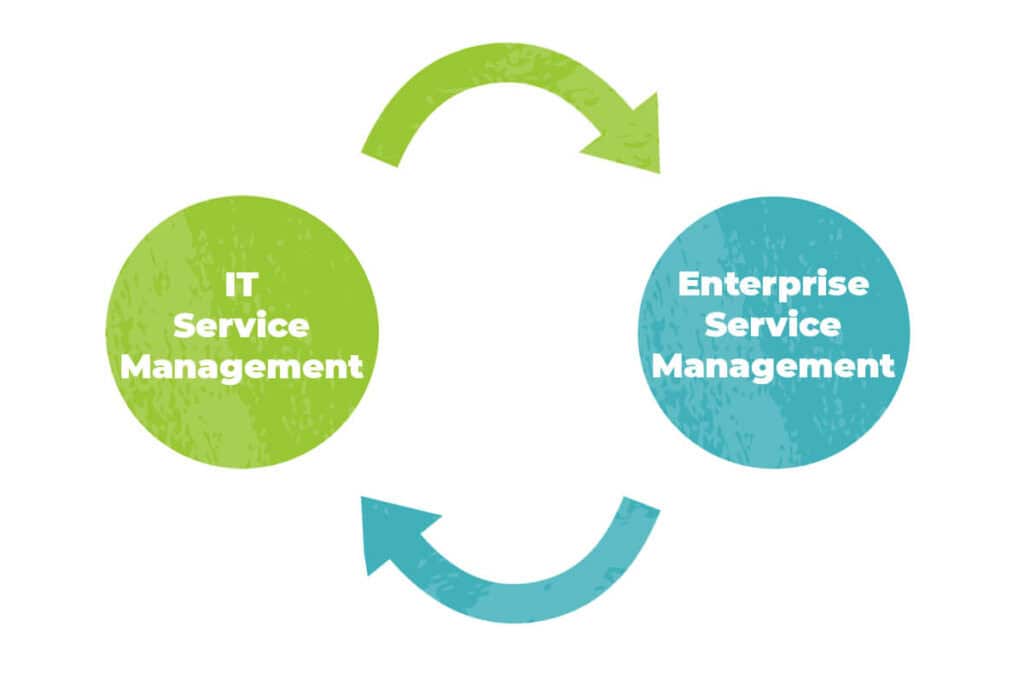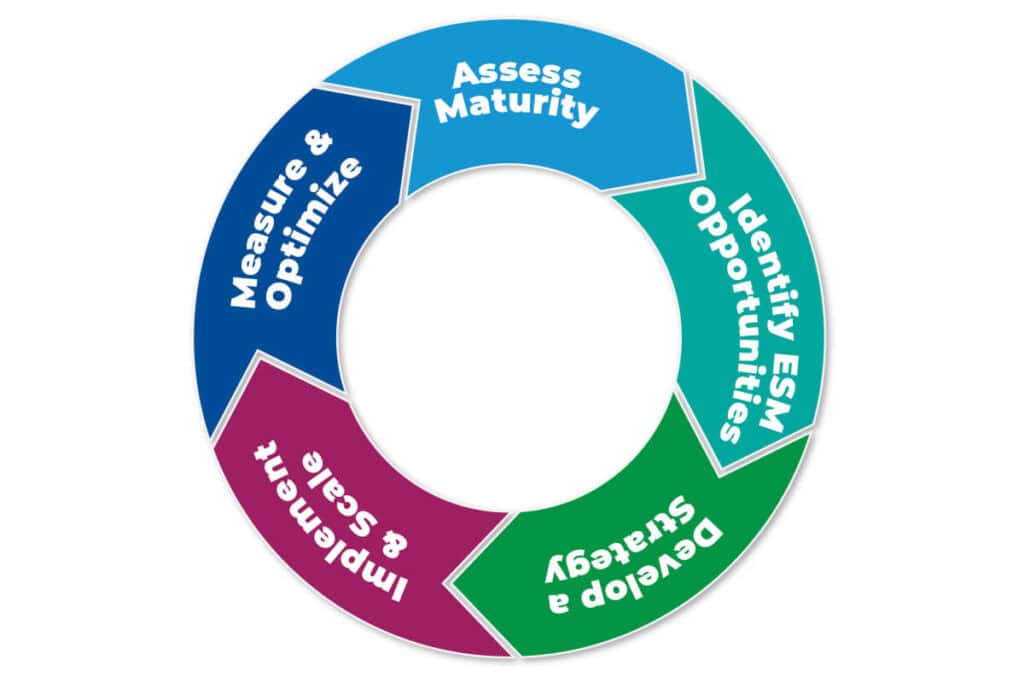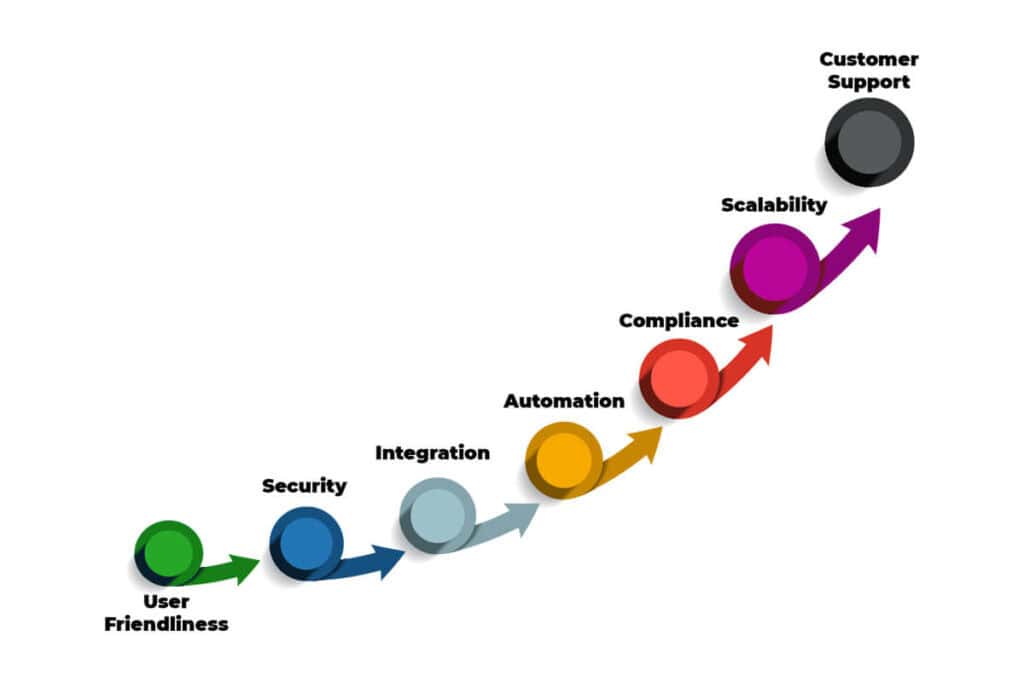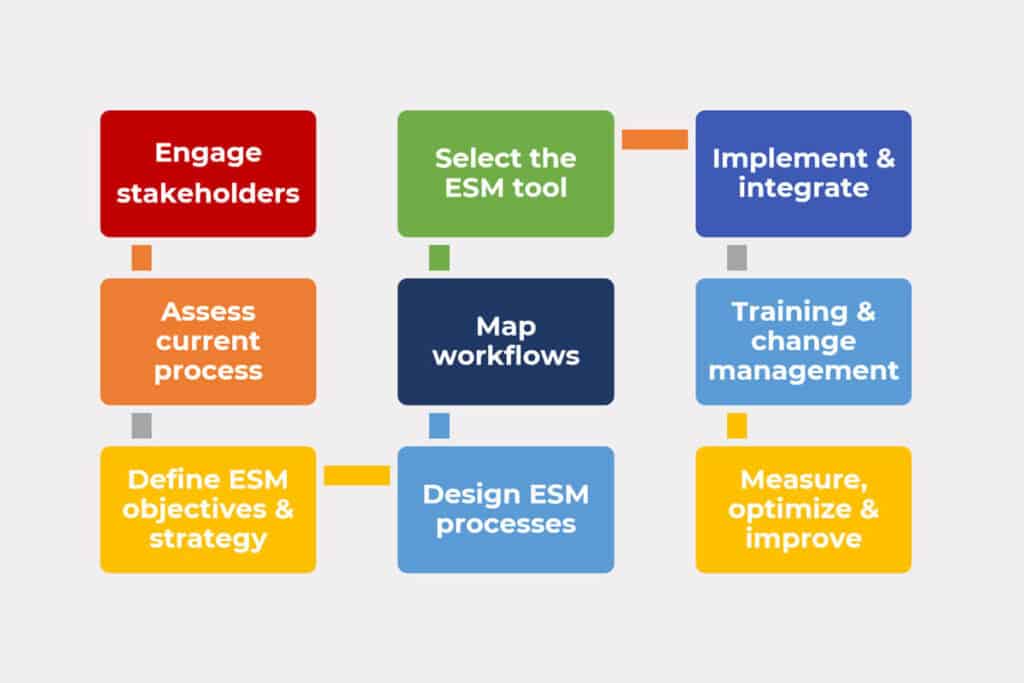Introduction: Venturing into Enterprise Service Management (ESM)
Enterprise service management is no longer the buzzword it was twenty or even ten years ago; rather, it represents delivering services across various business functions. Enterprise service management (ESM) involves a holistic view of delivering higher quality services across the entire organization, focusing on business functions that offer internal services directly to other employees and departments. This guide will take you through the basics, from defining ESM strategies to understanding the benefits they provide.
Table of Contents
Toggle
What is Enterprise Service Management?

Enterprise Service Management (ESM) fundamentally broadens the application of service management principles, which have historically been confined to the IT department, to encompass a wide array of business operations. It integrates into diverse areas such as human resources and customer service, guaranteeing that every facet of the company functions with unparalleled efficiency and smoothness. It enables departments that provide services within the organization to leverage tools IT has had for years, like the self-service portal. It sets the stage for coordinated efforts that involve more than a single group, like onboarding and employee moves, which typically involve IT, HR, and facilities.
Bridging ITSM and ESM: A Seamless Integration for Business Excellence

Understanding the relationship between IT Service Management (ITSM) and Enterprise Service Management (ESM) is crucial for organizations looking for enhanced operational efficiency and efficient service delivery. While ITSM focuses on managing the delivery of IT services to customers, ESM extends these principles and practices across the business, applying them to various non-IT departments of business functions such as human resources, finance, and customer service. What is enterprise service management? In a nutshell, it’s a sharing of processes and governance principles like the ones that follow.
Shared Principles and Practices
Both ITSM and ESM are grounded in the same foundational principles, such as service lifecycle management, continuous improvement, and a focus on customer satisfaction. By applying ITSM practices like incident management, request fulfillment, and problem management across other business functions, organizations can standardize and optimize their service delivery processes.
Technology and Tool Integration
ITSM tools have evolved to support ESM initiatives, offering platforms that can manage services beyond IT. This integration enables organizations to use a single system to manage requests, incidents, and changes across multiple departments, facilitating better communication and workflow efficiency. It also supports the service desk by creating a self-service portal representing all business functions.
Cultural Shift Towards Service Orientation
The adoption of ESM encourages a cultural shift within organizations, moving from departmental silos to a more integrated, service-oriented approach. This shift mirrors many IT departments’ journeys, promoting collaboration and a unified focus on delivering customer value.
Enhanced Efficiency and Agility
By extending ITSM best practices to other business areas, ESM helps organizations become more efficient and agile. This integrated approach ensures that all departments are aligned with the organization’s objectives, improving service quality and speeding up the delivery of services.
Improved User and Customer Experience
A key benefit of aligning ITSM and ESM is its enhanced experience for users and customers. With consistent management practices across the organization, users enjoy more streamlined interactions and quicker resolutions to their service requests, leading to higher customer satisfaction.
Steps for Integrating ITSM with ESM
When building on the solid foundation of ITSM, organizations can implement ESM to achieve greater efficiency, agility, and customer satisfaction.

- Assess Current ITSM Maturity: Understand the existing capabilities and maturity level of your ITSM practices and which ones apply to non-IT services. This assessment will provide insights into how and which practices can be extended to other business functions.
- Identify ESM Opportunities: Identify opportunities where ITSM principles can address service delivery challenges in other departments. Prioritize areas with the most significant impact on effective service delivery and customer satisfaction.
- Develop a Unified Strategy: Create a strategy that integrates ITSM and ESM objectives, ensuring alignment with overall business goals. This strategy should include technology, process adaptation, and cultural change plans.
- Implement and Scale: Start pilot projects in non-IT departments to apply ITSM practices and gauge their effectiveness. Refine your approach and scale ESM across the organization based on these pilots.
- Measure and Optimize: Continuously measure the impact of ESM initiatives against predefined metrics. Use this data to optimize processes and ensure that the integration of ITSM and ESM delivers the desired business outcomes.
This holistic approach streamlines internal operations and enhances the overall customer value. It enables providers to automate manual processes by automating key capabilities, improving the employee experience.
Critical Benefits of ESM: Essential Advantages for Your Business
Implementing Enterprise Service Management (ESM) is not just a strategic move; it’s imperative for organizations aiming to stay competitive and responsive to customer needs. ESM transcends traditional ITSM practices, bringing its principles and benefits to all business processes. Here’s why your business needs to embrace ESM, followed by a detailed exploration of its key benefits.
Enterprise Service: Consistently Delivered Across Service Providers
At its heart, ESM is about enhancing how services are delivered across multiple business functions, ensuring that every aspect of your organization operates at peak efficiency. This holistic approach to service management streamlines processes and fosters a culture of continuous improvement, driving consistent and cost-effective delivery of enterprise services. With ESM, businesses can adapt rapidly to market changes, meet customer expectations more effectively, and drive greater value from their operations.
Improved Operational Efficiency
ESM streamlines service delivery processes, eliminating redundancies and integrating workflows through departments. It focuses on the service value chain, a concept that engages customers to work with providers on creating value together, called value co-creation. The collaboration between providers and their customers enables improved business function operations and ensures providers can deliver the services they need. Some organizations include a global service desk, providing the human touch across all departments.
Enhanced Employee Satisfaction
ESM significantly boosts employee satisfaction by providing intuitive tools and processes that make their jobs easier. A streamlined workflow allows employees to focus on their core responsibilities, fostering a more productive and engaging work environment. Automating workflows for request management and making service requests available via an online service catalog standardizes services and provides a single place for employees to access all providers’ services.
Superior Service Delivery
Streamlined and automated workflows result in all employee services being delivered consistently, efficiently, and often at reduced costs. With processes optimized and standardized across the board, customers and employees benefit from reliable and effective service experiences.
Cost Reduction
One of the most compelling benefits of ESM is its ability to reduce operational costs by offering service channels outside the service desk for support. Businesses can achieve significant savings by automating routine tasks, optimizing resource utilization, and minimizing service disruptions.
Increased Visibility and Control
ESM platforms provide comprehensive dashboards and reporting tools that help providers gain valuable insights into the use of services and improvements in performance across the organization. This enhanced visibility allows managers to make informed decisions, identify improvement opportunities, and better control and improve service delivery outcomes.
Scalability and Flexibility
As businesses grow and evolve, their service management needs change. ESM solutions are designed to be scalable, supporting an organization’s growth and adapting to new business models, technologies, and customer demands. Self-service tools are more scalable than the service desk, enabling employees and customers to gain support and fulfill requests without engaging staff.
Improved Risk Management and Compliance
Implementing ESM helps organizations manage risk more effectively by standardizing processes and ensuring that best practices are followed. Additionally, it supports compliance with industry regulations and standards by providing audit trails and enforcing consistent procedures.
Fostering Innovation
ESM creates an environment conducive to innovation by freeing up the service desk and other resources and eliminating inefficiencies. Organizations can focus on developing new services, improving customer experiences, and exploring innovative business opportunities.
The Building Blocks of an ESM Strategy
Enterprise Service Management relies on its components: service catalogs, workflows, self-service portals, knowledge management, and dashboards, to name a few. These aren’t just fancy tools but the gears that keep the ESM engine running smoothly. They help standardize service delivery, ensuring that everyone’s working consistently, whether for incident management or employee onboarding. As building blocks, they form the foundation to enable enterprise service management strategies and deliver on the promise ESM offers.
How ESM Transforms Departments and Breaks Down Silos
One of the most magical aspects of enterprise service management is its ability to break down silos and foster collaboration among departments. Whether HR, finance, or marketing, ESM introduces a unified approach to managing services, ensuring the entire organization is aligned and moving towards common business objectives. Additionally, by bringing providers together to design cross-functional workflows, enterprise service management redefines each silo’s existing processes ESM workflows that move across departments at the correct times, ensuring on-time fulfillment.
Choosing the Right ESM Tools

From automation to customer support, venturing into selecting the appropriate enterprise service management (ESM) software can often resemble an intricate journey through a maze. The market has vast options, each boasting unique features and benefits. To navigate this complexity, it’s essential to zero in on several critical capabilities that stand as benchmarks for effective ESM solutions.
Automation
The ability of ESM tools to automate repetitive and time-consuming tasks cannot be overstated.

Automation enhances efficiency and reduces the likelihood of human error, improving the overall service delivery quality. Self-service request fulfillment can only be achieved when the service catalog tool has the right automation capabilities. Look for software that offers intelligent automation options for routine business processes, freeing up internal teams to focus on more strategic initiatives.
Integration
The modern business ecosystem is interconnected, making the integration capabilities of ESM tools a vital consideration. An ideal ESM solution should seamlessly integrate with IT infrastructure, Human Capital and Facility Management systems, and other business applications and services. This ensures a unified approach to service management across various departments, enabling data to flow effortlessly between systems and providing a holistic view of operations.
User-Friendliness
The effectiveness of any software largely depends on its adoption by its users. ESM tools should come with an intuitive interface and straightforward navigation, making it easy for all employees, regardless of their technical proficiency, to engage with the system. This increases the likelihood of widespread adoption and maximizes the impact of the ESM strategy within the organization.
Scalability
As businesses evolve, so do their service management needs. A scalable ESM solution can adapt to growing or changing business requirements without completely overhauling the system. This flexibility is crucial for long-term sustainability and ensuring that the tool remains an asset as your organization expands or shifts its focus.
Compliance and Security
Safeguarding sensitive data and ensuring compliance with regulatory standards is paramount, especially in ESM tools that include risk management and legal and human resource functions. ESM software should offer robust security features and compliance controls to protect against data breaches and ensure service management practices adhere to industry regulations and standards.
Customer Support and Community
Finally, the level of support provided by the ESM tool vendor and a supportive community or ecosystem around the product are important.

Access to expert assistance from corporate service providers, training resources, and a community for exchanging ideas can significantly enhance the value of the ESM solution and support your organization’s service management initiatives. Among the leading solutions in the market, Jira Service Management, a service management solution, stands out for its comprehensive approach to addressing a broad spectrum of business requirements. At the same time, ServiceNow offers service catalog functionality that protects the security of individual providers. Jira Service Management, ServiceNow, ManageEngine, Freshworks, and a host of other providers offer key ESM capabilities. By carefully evaluating functionality needs against those offered by tools like these, organizations can make informed decisions that align with their specific needs and goals, ensuring a successful implementation of enterprise service management that drives operational excellence and innovation.
Implementing ESM in Your Organization: Getting Your Ducks in a Row

Introducing enterprise service management systems into an organization is a strategic endeavor that requires careful planning and alignment with your company’s core objectives, culture, and processes. It’s not as simple as implementing a software solution; it’s fundamentally transforming how your organization delivers services across its various business functions and departments.
Steps for a Successful ESM Adoption Program

- Engage Stakeholders: Begin by rallying support from key stakeholders across the organization. Explain the benefits of ESM, addressing how it will meet the business’s needs and enhance service delivery. Achieving buy-in is critical for the success of the implementation process and should continue throughout program adoption and beyond.
- Assess Current Processes: Conduct a thorough review of existing service delivery processes across all enterprise providers to identify strengths, weaknesses, and areas for improvement. This assessment will provide a clear baseline from which to measure the impact of ESM.
- Define ESM Objectives and Strategy: Clearly outline what you aim to achieve with ESM, including specific goals such as improving service delivery speed, enhancing customer satisfaction, or reducing operational costs. An effective ESM strategy should align with broader business objectives while being based on service management principles.
- Design ESM Processes: Design the new service management processes or adapt existing ones to be managed through the ESM platform. This includes defining service catalogs, self-service portals, and escalation paths. The service management practices form the foundation for tool design.
- Map Workflows: Document the newly defined service management practices as workflows for implementation within the tool. Each business function should be documented by the people responsible for its delivery.
- Select the Right ESM Solution: Choose an ESM tool that fits your identified needs, considering factors like automation capabilities, ease of integration, user-friendliness, and scalability. The right tool should support your objectives and be capable of evolving with your organization.
- Implement and Integrate the ESM Tool: With a clear plan, implement the ESM software, integrating it with existing IT and business systems. Ensure that data flows seamlessly between systems for a unified service management approach and that the tool can carry out the organization’s service management principles.
- Training and Change Management: Develop comprehensive training programs for all users to ensure they understand how to use the new system effectively. Change management practices should be employed to assist with the transition, addressing any resistance and fostering a culture of continuous improvement.
- Monitor, Measure, and Optimize: After implementation, continuously monitor the performance of the ESM system against the predefined objectives. Collect feedback from users and customers to identify areas for improvement. Use this data to optimize processes and ensure the ESM solution meets business needs.
Future Trends in ESM: Peeking into the Crystal Ball

The future of ESM is clear: automation and innovation are key critical success factors
The current ESM landscape is dominated by AI and machine learning, where enterprise service management software not only automates mundane tasks but also predicts service needs and personalizes service delivery. The way employees engage with Enterprise Service Management systems and the providers who offer services through them will change, offering a far more user-friendly interface. Many organizations have integrated their self-service portals with corporate chat capabilities like Teams and Slack. This enables employees to engage the IT department and business functions using natural conversations with bots.
Winding Up: Your ESM Journey Starts Now
From the nitty-gritty of what enterprise service management is to its benefits, components, and bright future, it’s clear that ESM is not just a fleeting trend. It’s a robust approach to transforming how businesses operate, deliver services, and achieve their goals.
FAQs: Answering Your Burning Questions About ESM
Q: Can ESM be implemented in small businesses?
A: Absolutely! While the scale might differ, the principles and benefits of ESM apply to businesses of all sizes. It’s all about adapting the approach to fit your specific needs.
Q: How long does it take to see results from implementing ESM?
A: While ESM is an ongoing program, many organizations start seeing service delivery and employee satisfaction improvements within a few months.
Q: Is ESM suitable for non-IT departments?
A: Yes, indeed! Enterprise service management transcends traditional IT service management boundaries, bringing its principles to all business functions, from HR to facilities management.




